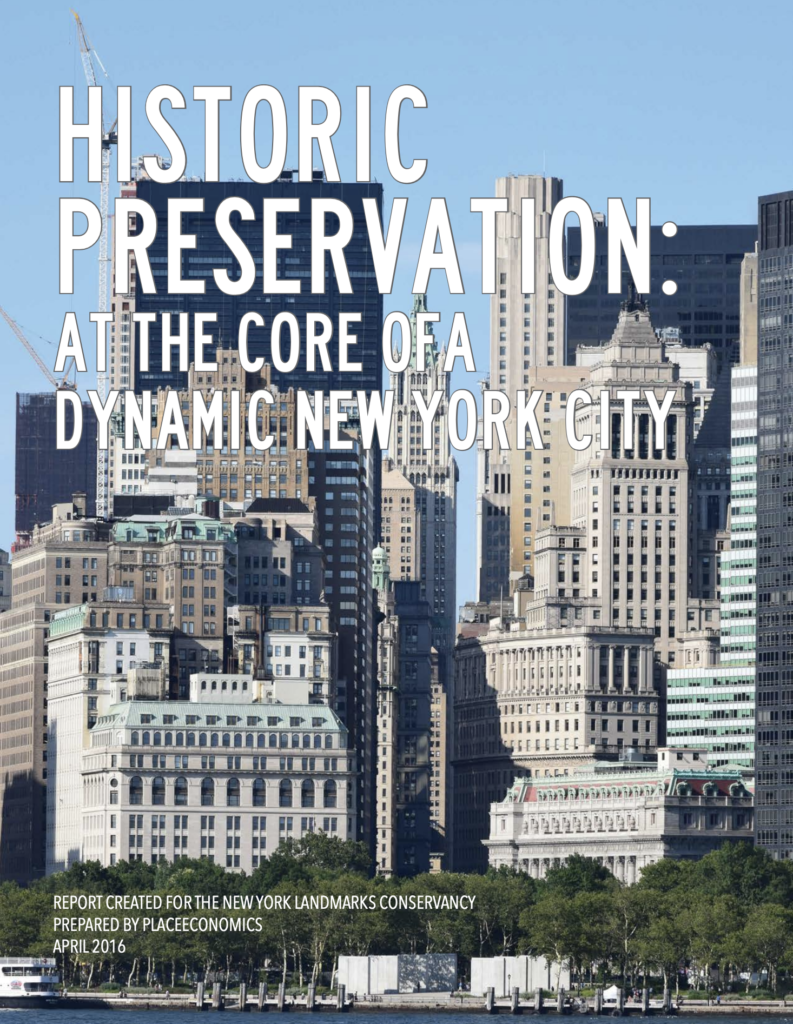Historic Preservation Economic Impact Study
Click on the link below for Report (Adobe Reader)
May 2016
The Landmarks Conservancy has released a groundbreaking study showing that historic buildings and neighborhoods are at the center of a dynamic, growing and diverse New York. The report is the most comprehensive look at the myriad ways preservation shapes the City, creating jobs, stimulating investment, attracting tourists and conserving energy.
Donovan Rypkema, principal of PlaceEconomics, presented highlights of the Conservancy’s report Historic Preservation: At the Core of a Dynamic New York City at a panel last week. He said the study should “reshape the conversation,” countering claims that landmarking is preventing growth.
Key findings include:
- More than $800 million is invested annually in New York’s historic buildings, creating jobs for 9,000 New Yorkers and providing paychecks of over $500 million each year.
- The creative industries are a rapidly growing and vital component of New York’s economy, and jobs in those industries are disproportionately found in historic districts.
- Heritage tourism is a major component of New York’s visitor industry. Just the domestic portion of that visitor segment provides jobs for 130,000 New Yorkers.
- Historic districts are the densest residential neighborhoods in every borough of New York City, usually having a density of two to three times that of the borough overall.
- Both historic office and apartment buildings use significantly less energy per square foot than their more recently built competitors.
- Historic Districts overall are diverse economically and demographically.
The report cites a New York Building Congress report that 2015 was a record year for construction activity in the City, producing 36,850 units of housing, the highest number of units in recent years. While the City has to add density, the report states “scapegoating neighborhoods that are already the densest in the City is both foolish and bad public policy.”
__________________________________________________________
Preservation Debate at NY Times Conference
July 2016
Donovan Rypkema of PlaceEconomics in D.C. delivered a powerful defense of preservation and historic districts, in a lively discussion with economist Ed Glaeser at the New York Times conference, “Cities for Tomorrow” on Tuesday.
Rypkema authored the Conservancy’s report Historic Preservation: At the Core of a Dynamic New York City, which articulated the many ways that preservation benefits New York, in terms of increased jobs, tourism, density, and sustainability.
Glaeser is a proponent of the theory that historic districts limit new building and therefore limit affordable housing. Rypkema countered that argument by noting that historic districts in New York account for less than 5% of land and lots across the five boroughs, leaving ample room for new development, and that characterizing historic districts as the villain in the struggle to create affordable housing is wrong.
Audience members were skeptical of Glaeser’s claims, asking how increased density would create affordable housing, when it has so often only added luxury condos. Glaeser excoriated New York’s regulatory process, saying it needed to be rethought. Rypkema cited a Building Congress report that lists recommendations to improve New York’s land use process, but does not even mention landmarking as an issue.
Glaeser conceded that preservation is “cool and interesting” and only a small part of the problem in creating affordable housing, while Rypkema noted that preservationists need to do a better job of explaining that preservation has evolved, and is no longer just about monuments and “old white guys,” but about African-American and Latino history, the LGBT community, and the character of the City. He also recommended that more New York developers explore combining the federal Low Income Housing Tax Credit and the Historic Tax Credit, a strategy that has been successful across the country.
__________________________________________________________
Preservation Reports presented to the public, May 2016
The May 2016 panel also included reports by the authors of two other preservation studies
Gretchen Maneval, of ThinkBrooklyn, the author of the Historic District Council’s The Intersection of Affordable Housing and Historic Districts provided a thorough analysis rebutting claims that landmarking is detrimental to affordable housing.
The JM Kaplan Fund and the NY Community Trust funded a report produced by NYU’s Furman Center, Fifty Years of Preservation in New York City. This white paper provided critical data, utilized in the other two reports, on statistics of landmark designations in New York. Furman’s Ingrid Gould Ellen presented a summary of those results, which conclude that LPC regulation extends to 3.4 percent of lots in New York City; that historic districts and nearby areas are equally dense; and that while historic districts saw fewer new buildings, lots in historic districts were no less likely to receive an alteration permit.
Combined, the reports give the best-ever analysis of preservation in New York City. They show that landmarking has had a significant beneficial impact on the City’s development, stimulating the economic growth, enhancing quality of life, and maintaining community.
__________________________________________________________
PlaceEconomics, which produced the report, is a Washington, DC-based real estate and economic development consulting firm. The focus of the firm’s work is at the intersection of historic preservation and economics. Heritage Strategies International is a sister firm that undertakes similar assignments outside of the US. PlaceEconomics has worked in 49 US states and Heritage Strategies International in more than 45 countries. Recently PlaceEconomics has completed studies on the impact of historic preservation in Savannah, Georgia; San Antonio, Texas; Raleigh, North Carolina; and Pittsburgh, Pennsylvania.

